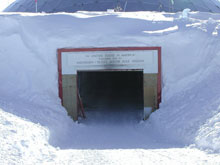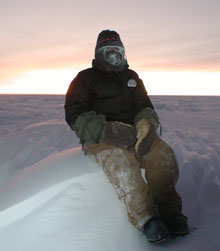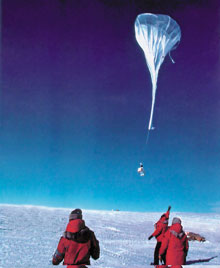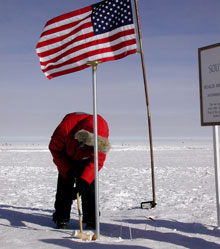It Was a Dark and Stormy Night – for Six Months!
What It's Like to "Winter Over" at the South Pole
NOAA carefully and consistently conducts observations around the world, including in the Arctic and Antarctica, to monitor gases and particles in the atmosphere. The data collected by NOAA are used by researchers and others to track trends and global distribution of atmospheric constituents, such as greenhouse gases, that are capable of forcing change in the Earth's climate, as well as those that may cause depletion of the global ozone layer, and those that affect air quality.
- Introduction
- NOAA at the South Pole
- Dark...But Beautiful
- Want to Winter Over?
- A Day in the Life
- All About Measurements
- Let's Play Twister!

An aerial view of the South Pole Observatory taken in 2004. Click image for larger view.
Literally at "the ends of the Earth," NOAA scientists have been observing the icy worlds of the Polar Regions for decades, braving six-month winters and working through summers when the sun never sets. The observations and discoveries these adventuring scientists contribute help NOAA understand and predict the Earth system, which includes the cryosphere (ice) as well as the atmsophere, hydrosphere, and biosphere.
Many researchers have made it to one or both Poles during their careers, but Antarctica in particular draws men and women looking for adventure and challenge in one of the last wild, untamed places on the planet. The recollections of two NOAA scientists who have “wintered over” at the South Pole Station reveal that the experience is unforgettable – mostly as a treasured memory, but also in the sense of "Whew, I made it through!"
NOAA at the South Pole

The Amundsen-Scott South Pole Station was built in 1997, allowing more scientists to “winter-over” in the South Pole. Click image for larger view.
NOAA collects data on carbon dioxide and other trace gases, including ozone, and monitors other parameters of the atmsophere at locations world-wide, including at both Antarctica and the Arctic. The record of carbon dioxide measurements at NOAA’s South Pole Observatory – at 89.99 degrees south latitude – goes back 50 years, to the International Geophysical Year (IGY) of 1957-1958.
Americans have occupied the geographic South Pole continuously since November 1956, as part of the IGY. The original South Pole station was constructed by a U.S. Navy crew during 1956-1957. A geodesic dome was home to researchers from 1975 to 1997, with detached buildings housing instruments for monitoring the upper and lower atmosphere and research in astronomy and astrophysics.
The Amundsen-Scott South Pole Station, built in 1997, now accommodates twice as many wintering-over scientists and support personnel as the dome did. The National Science Foundation (NSF), which manages U.S. interests at the South Pole, added the Atmospheric Research Observatory (ARO) in 1997 as well. The ARO is located about 500 meters upwind of the main station, separated intentionally from other station facilities.
Year-round activities of NOAA’s Earth System Research Laboratory scientists at the South Pole include measuring long-term trends of important trace gases, aerosols, and solar radiation and investigating the influence of these gases and aerosols on the Earth's climate. University scientists join those supported by NASA, NSF, and other science agencies at the South Pole Station to conduct a range of research.
Collection of atmospheric data is continued by NOAA’s Earth System Research Laboratory (ESRL) in Boulder, Colorado, where air samples taken in remote locations all over the globe are analyzed. The Global Monitoring Division of ESRL supports two full-time employees as the South Pole Station who operate and maintain the observatory and its data collection year-round.
Dark...But Beautiful
In the South Pole, the sun never rises during the winter months. So how does it feel to live in this extended darkness? It is not as bad as you might think, according to Don Neff, a NOAA employee who wintered over at the South Pole Observatory twice in recent years.
“I don’t mind it,” Neff said of the six dark winter months when scientists are cut off from the sun and from most of civilization at the bottom of the world. “Actually, the constant sunlight (of polar summers) is more annoying to me.”
Neff, who spent the winters of 1993-1994 and 1999-2000 at the Pole as one of two staff of NOAA’s monitoring laboratory, explained that the winter sky in Antarctica is compelling like no other place. “It’s really beautiful,” he said. “You have the Aurora (Australis, or Southern lights) and so many stars!” And this light show, undimmed by competing lights of populated places, plays all “day” long.
Inside the old South Pole Station, though, it wasn’t so beautiful, Neff remembered. In the winter of 1993-1994, 27 people, including seven women, wintered over in a station built for 19 men. Obviously, quarters were tight, amenities few, and the only places you could be by yourself were outside (not recommended when temperatures are at 50° F below zero) or your own room, assuming you did not have a roommate.
When you were in the main station, Neff said, there were always people up and about “whether it’s midnight or noon.” He enjoyed making food in the old station’s kitchen at any time and running into someone else in search of a snack.
The new station, built in 1997, boasts a full-service cafeteria, exercise facilities, and numerous entertainment options. And while these amenities might sound nice, they aren’t really to Neff’s liking. “It used to be an adventure; it was primitive and unstructured,” he said. He felt like he was living someplace distinctly different, not just another research lab with a southern address.

The new South Pole station includes all of the comforts of home…
With the “all-things-provided” new station came a more structured administration of the station. Neff said he preferred the old, relaxed atmosphere to the more regimented one.
Big changes came to the station even before that, he said, when women began wintering over at the South Pole about 20 years ago. The social dynamics were altered as “we tended to be more polite,” Neff said of the typical "manly" polar researcher. Nevertheless, in the cramped, close quarters, “It was not a place for a date.”
Want to Winter Over? I Do.
Another NOAA scientist who wintered over at the South Pole Station since the new station was built shared his thoughts about what turned out to be a life-changing experience for him.
Brian Vasel, also an ESRL global monitoring researcher, was half of the lab’s two-person team to spend 18 months at the South Pole in 2002 and 2003. He explained that generally the crew comes at the beginning of Antarctic spring, in late October, when the sun is lighting the horizon for the first time in six months. They train and learn the job with the prior-year crew and others until February. Then, the summer construction crews and others leave, and those who are left settle down for a long winter’s night.
Before a recruit even heads down under, operators of the South Pole Station ensure that everyone who is wintering over gets a psychological evaluation. After all, the others at the station don’t want to find out someone is claustrophobic or belligerent after the last plane has the left the station!
In 2002, in fact, one of the recruits did not get invited to stay the winter after a “psyche eval,” and managers of NOAA’s observatory had to scramble for a replacement. Brian Vasel walked into the observatory operations office in Boulder and thought they were kidding when they asked, “Want to go to the Pole?” He said yes, got ready to go in less than a month, and shipped out. Loreen Lock, a NOAA employee who had been working in halocarbon research in Boulder was already down at the South Pole preparing to be the other half of the NOAA contingent.
Vasel had trained Lock to launch ozone balloons when they both were in Boulder, so they already knew each other when they met again at the South Pole to run the observatory. During the next months, they worked side-by-side, collecting various measurements for NOAA in the cold and dark at the South Pole. “We were a team” said Vasel, the only two NOAA employees at the station. One day – and it was the same for both of them – they were hit by what Vasel calls “an epiphany.” They had fallen in love with each other.
The two are now married. While Vasel continues at the NOAA lab in Boulder, Lock is working in the Emergency Department at Children’s Hospital in Denver to gain enough patient care hours to apply for medical school to pursue a career as a physician’s assistant.
A Day in the Life
One wakes up at the South Pole in the winter whenever one wakes up – there is no getting up with the sun when the sun does not come up.

The smaller half of NOAA’s researcher team at the South Pole in 2002 was petite Loreen Lock, who gained 20 pounds when she layered up to head outside in bitter temperatures, which can plunge to minus 140° F – or lower. Click image for larger view.
Breakfast is usually a social affair, where one catches up with what other researchers are doing and gets prepared, in the case of the NOAA pair, to head outside to the observatory, located about a kilometer from the main station.
The whole morning, Neff remembered, “you are mentally preparing to go outside.” Depending on how much “winter lethargy” is dragging you down, mind preparations can take awhile. Then you have to get physically ready...that is, you have to get dressed.
As winter sports enthusiasts know, dressing to go out in the cold is all about layers. At the South Pole, this means lots of layers...over every conceivable part of the body. When you are fully clothed, only your eyes peak out at the frigid world from frequently fogged goggles.
Vasel commented that his wife, who is a petite woman, gained an extra 20 pounds when she put on her outdoor gear, and had to haul that weight around with her as she went out.
It's All About the Measurements
Once the NOAA crew makes it out to NOAA’s Atmospheric Research Observatory, the work day begins. It could end in only half an hour, depending on the day’s protocol and whether the wide array of mostly automated instruments are cooperating with their human overseers.

For the NOAA team that winters over at the South Pole Station, one of the regular duties is launching ozone balloons and recording the data that is sent back to researchers by the instruments on the ozonesonde. Click image for larger view.
Other days, it could take 20 hours or more while the team struggles to get an instrument to operate accurately or repair a pump or heater in the bitter, difficult environment.
Every day there is "in-situ" air sampling at the observatory. These observations maintain the 50-year record for greenhouse gases, particularly carbon dioxide. Flasks of air are collected weekly and are eventually shipped back to the Boulder lab for analysis. Measurements are taken of particles in the air and of other trace gases such as nitrous oxide.
Once a week, an ozone balloon is launched, with its instrument package sending data back to a researcher monitoring a computer in Boulder. As the Antarctic spring approaches, ozonesondes are released more frequently to monitor the spring-time depletion of ozone in the upper atmsophere known as the “ozone hole.”
The NOAA crew also maintains measurements as part of cooperative agreements with other science entities. For example, they oversee observations of a micro-pulse LIDAR that looks at clouds in the upper and lower atmosphere for scientists at NASA.
Let’s Play Twister!
After the work is done, it is back to the station for play. There’s a pool table, and while Neff said he got pretty good at the game, he also got sick of it after awhile. There also are hundreds of VHS or DVD films to watch.

Researchers take a little time out for some croquet outside the South Pole Observatory in 2005. Click image for larger view.
Neff said to imagine the fun and games you haven’t enjoyed since you were a teenager. "Twister?" he’s asked. "Yes, and lots of cards and board games." He said a band or two usually forms during the winter to play music during off times and entertain for parties.
What is the hardest part about wintering over at the South Pole? Now that technology allows easier communication with the folks back home, it is missing special events, Vasel said, like friends getting married and babies being born.
What is the best part? The people, Vasel said. He said the adventure of the assignment was what initially attracted him, but in the end, it was the community one develops with fellow Pole scientists and staff.
He said conversations with one’s fellows at the South Pole are more meaningful and intimate than chit-chat one has in the elevator at a typical workplace or the standard banter by the water cooler. "You learn how to listen better,” he said, “and develop really close bonds with people."
"We look out for each other," he said.
Contributed by Carol Knight, NOAA’s Office of Oceanic and Atmospheric Research
